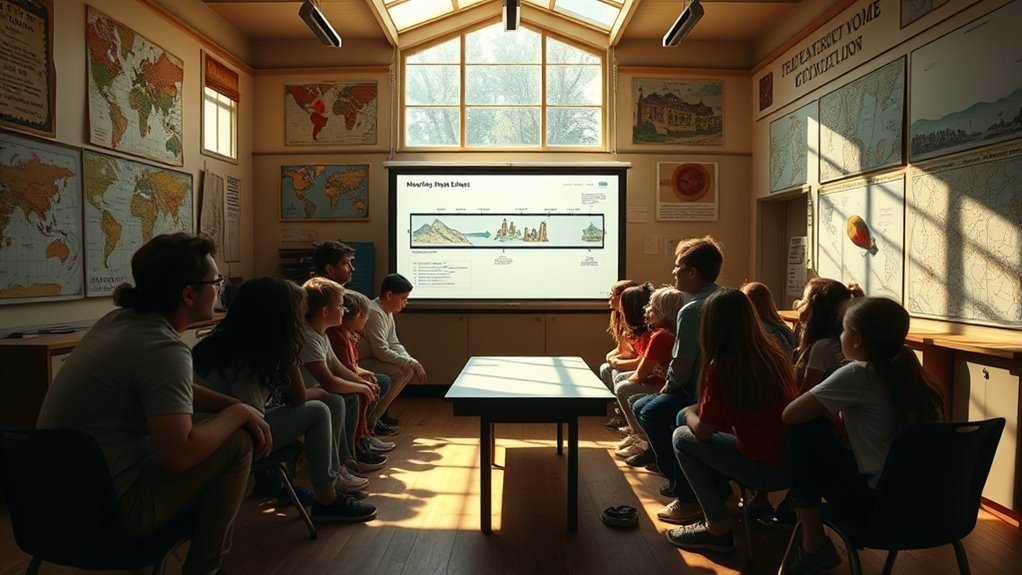Prompt engineering for history lessons transforms the way you engage students. By crafting effective, open-ended questions, you encourage critical thinking and personal connections to historical events. These prompts not only spark interest but also allow for diverse viewpoints and in-depth analysis of primary sources. As students interact and reflect, they take ownership of their learning. Keep exploring the benefits and techniques of prompt engineering, and you’ll discover even more strategies to enhance your history teaching.
Understanding Prompt Engineering in Education
As educators increasingly integrate technology into the classroom, understanding prompt engineering becomes essential for enhancing student engagement and learning outcomes. You’ll discover that different prompt types can greatly influence student responses, shaping their critical thinking and creativity. By crafting well-structured prompts, you can guide students toward deeper exploration of historical concepts. It’s not just about asking questions; it’s about encouraging dialogue, reflection, and analysis. By harnessing prompt engineering, you empower students to take ownership of their learning, fostering a sense of freedom in their academic journey. Embracing this approach ultimately leads to richer educational experiences and more meaningful connections with history.
Benefits of Using Prompt Engineering in History Lessons
Crafting effective prompts in history lessons can transform how students interact with the subject matter. By embedding historical context within these prompts, you empower students to connect past events with their own lives, fostering a deeper understanding. This connection greatly boosts student motivation, making learning feel relevant and engaging. When students see the real-world implications of historical events, their curiosity is piqued, encouraging them to explore further. Additionally, prompts that challenge critical thinking can lead to lively discussions, allowing students to express their ideas freely. Ultimately, prompt engineering enriches history lessons, creating a dynamic learning environment that inspires freedom of thought.
Crafting Effective Prompts for Historical Inquiry
How can you create prompts that truly spark historical inquiry? Effective prompts encourage students to explore various historical perspectives while honing their critical thinking skills. Here are some strategies to contemplate:
Creating effective historical prompts encourages exploration of diverse perspectives and sharpens critical thinking skills in students.
- Ask open-ended questions that invite debate.
- Encourage connections between past and present events.
- Challenge students to analyze primary sources critically.
- Promote exploration of diverse viewpoints within historical narratives.
- Foster discussions that allow for personal interpretations.
Examples of Prompts for Engaging History Lessons
What makes a history lesson truly memorable? It often stems from engaging prompts that encourage exploration of historical narratives. For instance, you might ask students to create interactive timelines that showcase pivotal events, allowing them to visualize connections and causations. Another prompt could involve debating the perspectives of historical figures, pushing students to analyze motivations and consequences. You could also encourage them to write letters from the viewpoint of someone living in a specific era, fostering empathy and deeper understanding. These prompts not only spark curiosity but also empower students to take control of their learning journey through history.
Assessing Student Engagement and Learning Outcomes
While engaging prompts can ignite a passion for history, evaluating student engagement and learning outcomes is essential to understanding the effectiveness of these strategies. To assess student motivation and learning assessment effectively, consider these approaches:
- Surveys and Questionnaires: Gather feedback on prompts and lessons.
- Class Participation: Observe student involvement during discussions.
- Performance Tasks: Assess projects or presentations to measure understanding.
- Reflection Journals: Encourage students to articulate their learning experiences.
- Peer Assessments: Allow students to evaluate each other’s work.



